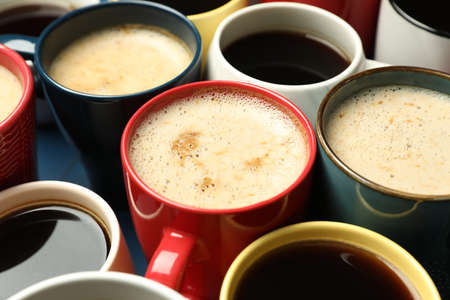Introduction: The British Mug and Its Ritual
In the UK, the humble mug is far more than just a vessel for your morning coffee or afternoon tea—its a cultural icon woven into the fabric of daily life. Whether perched on an office desk, warming hands during a rainy afternoon, or sparking conversation at a kitchen table, the British mug is synonymous with comfort and routine. This seemingly simple cup carries with it generations of tradition, personal preference, and even social signalling. In Britain, ones choice of mug often reflects not only aesthetic taste but also deeply held rituals surrounding the brewing and enjoyment of hot drinks. As we delve deeper into the nuances of cup selection, well uncover how these everyday choices profoundly shape both the flavour profile of your coffee and the overall drinking experience. By understanding the significance of the mug in British culture, we set the stage to appreciate how this unassuming object can elevate—or undermine—the perfect brew.
Material Matters: Ceramic, China, and Beyond
When it comes to enjoying a proper cup of coffee in Britain, the material of your mug is far from a trivial detail. Each mug material—be it classic ceramic, elegant bone china, or durable enamel—plays a distinct role in shaping your coffee’s temperature, aromatic profile, and flavour clarity. Understanding these differences is essential for both casual drinkers and dedicated aficionados seeking to elevate their daily brew.
Ceramic: The Everyday Essential
Ceramic mugs are ubiquitous across British households and offices. Their popularity stems from their excellent heat retention and neutral taste profile. With a slightly porous structure, ceramics gently insulate your coffee, keeping it warmer for longer while not interfering with delicate flavour notes. However, cheaper ceramics may introduce slight mineral tastes or inconsistencies in aroma.
Bone China: The Refined Choice
No discussion of British mug culture would be complete without mentioning bone china—a staple of afternoon tea but increasingly popular for coffee as well. Bone china’s ultra-smooth surface ensures that aromas remain crisp and untainted. Its thin walls allow for a lighter drinking experience, though this comes at the expense of heat retention; coffee cools more quickly in bone china than in heavier ceramics.
Enamel: Rugged and Retro
Enamel mugs, often associated with camping trips and rustic charm, are making a comeback in contemporary British coffee culture. These metal-based mugs coated with enamel are highly durable and lightweight. While they offer rapid heat conduction—meaning your coffee reaches drinking temperature swiftly—they also lose heat fast. Some purists argue that the metallic undertones can slightly alter both aroma and flavour clarity, especially as the mug ages or if chipped.
Comparison Table: British Mug Materials
| Mug Material | Heat Retention | Aroma Preservation | Flavour Clarity | Common Usage Context |
|---|---|---|---|---|
| Ceramic | High | Good (if quality glaze) | Neutral to mild enhancement | Everyday use at home/workplace |
| Bone China | Moderate to Low | Excellent (non-porous) | Crisp, unadulterated flavours | Formal settings, afternoon tea, special occasions |
| Enamel | Low | Adequate (may gain metallic hints) | Slightly altered by metal base over time | Outdoors, retro-themed cafés, travel |
The Bottom Line for Discerning Drinkers
Your choice of mug material is more than just an aesthetic preference—it’s a technical decision that shapes every sip. Whether you gravitate towards the warmth-preserving qualities of ceramic, the refined sensory clarity of bone china, or the robust practicality of enamel, selecting the right vessel ensures your British coffee ritual is both authentic and optimised for taste.

3. Shape, Size, and Lip: Engineering the Perfect Sip
The structural design of British mugs is far from arbitrary—each element, from shape to lip thickness, plays a crucial role in shaping your coffee’s flavour profile and overall sensory experience. Traditional British tankards, with their robust bodies and broad bases, offer excellent heat retention but can sometimes disperse aroma more rapidly due to their wide openings. In contrast, dainty porcelain cups with narrower mouths concentrate the bouquet, allowing for a more aromatic sip—ideal for those who relish the nuanced notes of specialty coffees.
Size also matters when it comes to British coffee culture. A larger mug not only delivers that comforting sense of abundance but also influences how quickly your brew cools; greater surface area leads to faster heat dissipation. Conversely, smaller cups maintain temperature for longer and encourage mindful sipping. The thickness and curvature of the lip subtly affect how coffee flows onto the palate: a thin, gently flared rim guides coffee smoothly and evenly, while thicker rims provide a sturdier, more rustic feel but may dull the initial impact of delicate aromas.
British mug engineering reflects both tradition and innovation—marrying centuries-old craftsmanship with a modern understanding of how vessel geometry shapes taste perception. Whether you favour a chunky stoneware beaker or an elegant bone china cup, your choice directly alters the interplay between temperature control, aroma concentration, and tactile pleasure. In essence, selecting the right mug is as much about technical performance as it is about personal ritual within the British coffee experience.
4. Aesthetics and Sentiment: The Psychological Impact of Your Favourite Mug
When it comes to coffee, the British ritual often extends far beyond mere taste and caffeine. The choice of mug is deeply woven into both personal sentiment and collective culture, impacting not only how coffee is enjoyed but also how its flavour is perceived. Scientific studies indicate that visual and tactile cues—such as a mug’s design, colour, and even its weight—can influence sensory perception, altering everything from aroma to perceived sweetness or bitterness.
The Visual Palette: How Colour Influences Flavour Perception
Colour psychology has long been acknowledged in the world of gastronomy, and your morning brew is no exception. In Britain, mugs range from classic white bone china to playful novelty designs adorned with regional motifs or witty sayings. The colour of your cup can subtly prime your brain for certain flavour notes; for instance, a blue mug may enhance perceptions of smoothness, while red can amplify the sense of intensity.
| Mug Colour | Common Associations | Potential Flavour Impact |
|---|---|---|
| White | Crisp, clean, traditional | Highlights acidity and brightness in lighter roasts |
| Blue | Calming, cool, trustworthy | May accentuate smoothness and reduce perceived bitterness |
| Red | Bold, energetic, stimulating | Tends to intensify flavours and perceived strength |
| Green | Natural, fresh, earthy | Can enhance herbal or vegetal tasting notes |
| Patterned/Novelty | Nostalgic, playful, expressive | Adds personal meaning; may heighten enjoyment regardless of flavour profile |
The Sentimental Brew: Personal History and Ritual
A cherished mug isn’t merely a vessel—it’s a part of one’s daily ritual and often carries emotional resonance. Whether it’s an heirloom Royal Doulton cup passed down through generations or a contemporary “World’s Best Dad” mug gifted on Father’s Day, these objects become intertwined with memory and comfort. This emotional connection can actually enhance sensory enjoyment: familiar mugs have been shown to increase relaxation, making the coffee drinking experience richer and more satisfying.
The British Cultural Context: More Than Just Tea Time
While Britain is renowned for its tea traditions, the national affection for coffee has grown steadily. Alongside this rise in specialty coffee culture is a distinct appreciation for mugs that reflect personality or local identity—be it emblazoned with a favourite football club or featuring quintessentially British humour. Selecting a specific mug can signal the beginning of a treasured moment of pause in an otherwise busy day—a small act that amplifies satisfaction through both taste and nostalgia.
Sensory Synergy: Mug Design Meets Coffee Profile
The psychological impact of cup selection is not just about aesthetics or sentiment alone; it is the synergy between design, memory, and sensory expectation that shapes each sip. For those seeking to truly elevate their at-home brewing experience, considering the interplay between mug characteristics and preferred coffee styles can be transformative. Ultimately, the right mug doesn’t just hold coffee—it enhances every aspect of your daily ritual.
5. Mug Maintenance: How Cleaning and Ageing Affect Flavour Profiles
Among British coffee enthusiasts, the importance of mug maintenance is often underestimated, yet it plays a pivotal role in shaping the flavour profile and overall experience of every brew. Proper hygiene practices ensure that each cup of coffee is enjoyed as intended by the roaster, while neglect or tradition-driven habits such as ‘seasoning’ can introduce nuanced changes to your daily cup.
Technical Best Practices for Mug Hygiene
From a technical standpoint, regular cleaning with non-perfumed detergents and thorough rinsing with hot water are essential. Ceramic and porcelain mugs, both staples in British homes, are particularly prone to absorbing oils and tannins from coffee, which can linger even after a casual rinse. Stainless steel travel mugs, increasingly popular across the UK’s on-the-go culture, may require special attention to avoid metallic taints or odour build-up. Consistent cleaning not only maintains the vessel’s integrity but preserves the clarity of distinct coffee notes, ensuring your single-origin Ethiopian filter or rich Italian roast espresso isn’t marred by yesterday’s residue.
The Impact of Lingering Residues
Residual coffee oils and micro-particles accumulate over time, creating a thin film inside your mug. This subtle layer can interfere with extraction balance and mouthfeel, especially noticeable in lighter roasts where delicate acidity and floral notes are prized. For British drinkers who prefer adding milk—a hallmark of local coffee culture—these residues interact with dairy fats, further muting brightness and complicating the flavour profile. A simple yet often overlooked tip: invest in a dedicated mug brush and avoid abrasive sponges which can scratch glazed surfaces and encourage more rapid build-up.
The Role of Seasoning in Crockery
In certain circles, particularly among those nostalgic for traditional English crockery, there’s a belief that ‘seasoned’ mugs enhance the coffee experience, much like a well-loved teapot develops character over years of use. While there’s a cultural charm to this approach, technically speaking, seasoned mugs introduce unpredictability to brewing consistency—flavour notes may be rounded off or muddied altogether. For those pursuing precision in their daily cup or exploring specialty brews, clean mugs yield the truest representation of origin and roast profile.
Brewing Consistency: Striking the Right Balance
Ultimately, maintaining your mug is about striking a balance between personal ritual and technical best practice. Whether you cherish the patina of an heirloom bone china mug or favour the crisp neutrality of freshly cleaned glassware, understanding how cleanliness—and even ageing—impacts flavour empowers you to tailor your brewing routine. In the context of British coffee culture, where tradition meets innovation at every turn, mindful mug maintenance ensures each pour is as satisfying as it is expressive.
6. Coffee at Home vs. High Street Cafés: British Mug Traditions in Context
When it comes to the quintessential British coffee experience, the distinction between home and high street café environments is marked not only by atmosphere but also by mug selection—a detail that subtly yet powerfully shapes both brewing method and sensory outcome. In British households, the humble mug reigns supreme: sturdy, generous in size, and often adorned with personal motifs or classic patterns. These mugs are designed for comfort, allowing for leisurely sipping and heat retention during extended conversations or morning routines. The home environment encourages experimentation with brewing methods—be it a classic cafetière, stovetop moka pot, or increasingly popular pour-over—each benefiting from the thermal properties and familiarity of the domestic mug.
Contrast this with the commercial setting of Britain’s high street cafés, where cup selection is tailored towards efficiency, presentation, and enhancing specific flavour profiles. Here, baristas select from a range of vessels—flat white cups, tulip glasses, or traditional cappuccino bowls—each engineered to accentuate crema, showcase latte art, or control temperature dissipation for optimal drinking windows. Café cups are typically smaller than their domestic counterparts, designed to concentrate aromas and encourage mindful appreciation of complex notes within specialty coffees.
This divergence in vessel choice reflects broader cultural attitudes: at home, coffee is integrated into daily life as a comforting ritual; in cafés, it becomes an event—an indulgence to be savoured, often accompanied by social interaction or work. The tactile qualities of each vessel—the weight of a ceramic mug versus the delicate rim of a porcelain cup—can profoundly alter perceived mouthfeel and flavour clarity. Moreover, cafés may employ pre-warmed cups to maintain extraction integrity and deliver a consistent sensory experience from first sip to last drop.
Ultimately, both settings demonstrate how the British approach to mug tradition impacts not just aesthetics but the very chemistry of coffee enjoyment. Whether cradling a beloved oversized mug at home or sipping from a meticulously chosen cup on the high street, the relationship between vessel, environment, and brew method remains central to shaping one’s overall sensory journey.
7. Conclusion: Optimising Your British Coffee Ritual
In conclusion, the simple act of choosing the right mug is far more than a question of aesthetics or tradition—it is a pivotal part of crafting an authentic British coffee experience. As we have explored, the interplay between cup shape, material, and size directly influences temperature retention, aroma development, and flavour clarity, all essential components for appreciating specialty coffee at its best. Culturally, the British reverence for the perfect cuppa extends from tea to coffee; our rituals are steeped in heritage and social connection, making mindful mug selection a meaningful touchstone in daily life. By considering technical attributes—be it porcelain’s heat stability or the tactile pleasure of a stoneware handle—and aligning them with sensory expectations, every brew becomes a celebration of both science and tradition. Ultimately, enhancing your coffee ritual by selecting the ideal mug not only elevates flavour but also honours the distinctive British approach to hospitality and enjoyment. So next time you reach for your morning coffee, remember: your choice of cup is as integral to the experience as the beans themselves.

